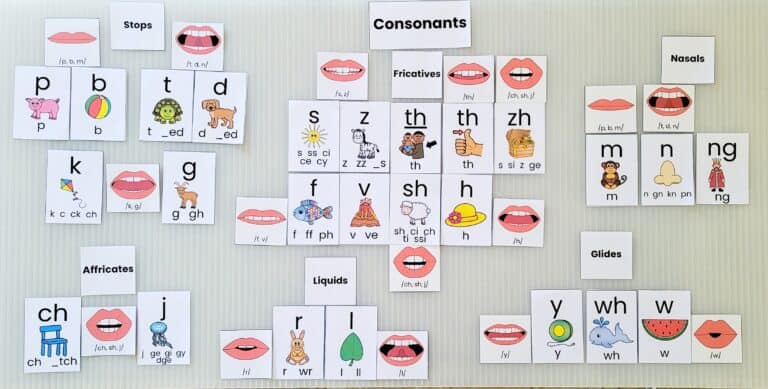The Importance of Onset and Rime + Suggested Activities
This post may contain affiliate links, and I will earn a commission if you purchase through these links. Please read the disclosure policy for more details.
Have you ever wondered how young children become successful readers and writers? Well, it all begins with developing their phonemic awareness skills. One crucial skill to learn is onset and rime. But what exactly is onset and rime? Why are they so important? And how can we help our students learn these skills?
In this blog post, we will explore the answers to these questions and suggest some engaging onset and rime activities for your students. So, let’s dive in and discover the world of onset and rime together!
SCIENCE OF READING QUICK START GUIDE
Grab your FREE guide with the 5 tools you need to get started with SOR!
*Most school spam filters block my emails, so please use a personal email.

Onset and Rime: What is it?
Onset and rime is a phonological awareness skill that helps children break down words into smaller parts. The onset refers to the initial consonant or consonant blend in a word, while the rime refers to the vowel and any consonant sounds that follow the onset. For example, the onset of the word “cat” is /k/, and the rime is /at/.
Onset and rime can be taught as a pre-reading skill to help children recognize patterns in words. It is an important skill because it helps children learn to read by recognizing common letter patterns and sounds. Children who have a strong sense of onset and rime are better prepared to learn decoding skills and become successful readers.
Why are Onset and Rime Important?
Onset and rime are important components of phonemic awareness because they provide a foundation for early reading and spelling skills. By being able to recognize and manipulate onset and rime, students can begin to break down words into smaller parts and identify patterns within words.

When looking at phonological awareness skills overall, knowing how to segment and blend onset and rime come before working with phonemes. The graphic below from The National Center on Improving Literacy illustrates this well.
When students can recognize the onset (the initial consonant or consonant blend) and the rime (the vowel and any remaining consonants) of a word, they can use this knowledge to decode new words and improve their reading fluency. For example, if a student knows that the onset of the word “cat” is /k/ and the rime is /at/, they can use this knowledge to sound out words like “bat,” “hat,” and “mat.”
Additionally, understanding onset and rime can help students with their spelling skills. By recognizing common rime patterns, such as “-ight” or “-ake,” students can apply this knowledge when spelling new words and begin to develop a better understanding of word families and how words are related.
Onset and Rime Activities
Now that you understand the importance of onset and rime in phonemic awareness, let’s dive into some fun activities to help your students practice this important skill.

1. Read books with rhymes.
The best way to introduce the idea of onset and rime is to read books that contain lots of rhyming patterns.
Some good choices are There’s a Wocket in My Pocket, There Was an Old Lady Who Swallowed a Fly, and The Cat in the Hat.
You could also sing songs with rhymes and play rhyming games.
2. Word Building:
Give your students a set of onset cards (e.g. b, t, m) and a set of rime cards (e.g. at, an, ip). Ask them to combine an onset card with a rime card to create a real word (e.g. b+at=bat, t+an=tan). This activity can be done individually or in pairs.

You could also do this with magnetic letters or phonogram cards.
3. Rhyming Bingo:
Create bingo cards with pictures or words that rhyme and call out onset and rime pairs (e.g. “at” and “b”). Students will cover the corresponding picture or word if they have it on their bingo card.
4. Word Families:
Choose a word family (e.g. -an) and write it on the board. Have students brainstorm as many words as they can that belong to that word family (e.g. can, fan, man, pan).

5. Roll and Read:
Create a dice with onset letters and another with rime letters. Have students roll both dice and read the resulting word out loud. This activity can be done individually or in pairs.
6. Sound Sort:
Provide students with a set of picture cards and ask them to sort the cards based on their onset or rime sound (e.g. all cards with the “/b/” sound go in one pile, all cards with the “/at/” sound go in another pile).

7. Phonological Awareness Tasks
Daily phonological awareness drills are an easy no prep method of adding some onset and rime practice to your daily lessons.
To do this with onset and rime, say a one syllable word and ask students to repeat it without the onset or without the rime.
Here is an example using the onset:
Teacher says: “Say ball.” Students say ball. Teacher says: “Say ball, but don’t say /b/.” Students say /all/.
I have a set of Phonemic Awareness Daily Task Cards that includes several cards focusing on onset and rime.
By incorporating these onset and rime activities into your phonemic awareness lessons, you will help your students develop strong reading skills and a love for literacy.
Final Thoughts on Onset and Rime
Onset and rime are crucial components of phonemic awareness and are essential for building a strong foundation in reading. By providing your students with opportunities to practice this skill through fun and engaging activities, you will help them become confident and successful readers.
Ready to take your reading teaching to the next level? Don’t let the valuable insights in this post get buried in your bookmarks! Save it to your Pinterest board today so you can easily come back to it whenever you need a dose of inspiration. Whether you’re looking to motivate struggling readers or you simply want to up your literacy game, this post has got you covered. So what are you waiting for? Give that pin button a click and get ready to take your teaching skills to new heights!









